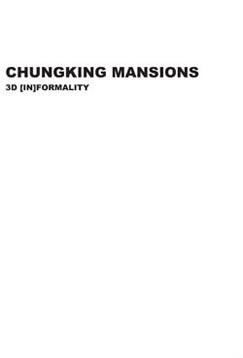Chungking Mansions - 3D [In]Formality

Students: Marcel Jäggi, Jacob Jansen
in collaboration with CUHK Student Man Hang William Wong
Location: Group work in Hong Kong
Date: June, 2008
Type: Research project, student work, minorities
Hong Kong’s extraordinary population dynamics has been one of the motors behind its rapid growth, but also behind its extraordinary patterns of occupation of urban space described by Akbar Abbas as a space of ‘migrants, immigrants and urban nomads’. The presence of trans-national migration in Hong Kong is specific and peculiar. These minorities, mainly work force coming from countries of South-Eastern Asia, constitute about 3% of the population and occupy discrete, particular spaces in the city, where influence of different cultures leaves an impression of a cosmopolitan public sphere. It also appears that for the Hong Kong migrants, minority national identity becomes synonymous to a particular working profile, i.e.: Pakistani or Hindu ‘guards’ and ‘construction workers’, Nepalese ‘drivers’, Filipino ‘nannies’, etc. Lets take for example Norman Foster’s Hong Kong and Shanghai Bank. From Monday to Saturday, the square in front and underneath the building serves as a passageway for businessman, government workers, tourists and shoppers. On Sundays, Filipino domestic helpers populate the square using their time off to meet and relax, transforming this centre of finance and commerce into a home-away-from-home known as the ‘Little Manila’. Their presence grew since the 1970s, in parallel to Hong Kong’s economic boom, to reach the current figure of 300.000.
The Chunking Mansions in Kowloon, internationally famous urban icon of Hong Kong, are a place where 3D megastructure is occupied with an indescribable mixture and intensity - smells, sounds, cluttering goods and groups of traders, workers, inhabitants, backpackers and shoppers anywhere from Africa, India, Pakistan to Europe. With its endless corridors and labyrinthine floor plans harbouring even spaces beyond view or reach, one has an impression of a place that runs according to its own rules, a peculiar hybrid of legality and illegality.
Amidst Hong Kong’s public spaces, more and more dominated by corporate influence, constructed and maintained by developers, the presence of cultures who use space according to their own cultural models and needs, as benign as it may appear – hawking small goods, sleeping, sitting, eating, hanging around – does stand out as an alternative, less controlled, public sphere. In some of these spaces, i.e. Central, migrant worker organizations and NGOs such as UNIFIL (United Filipinos in Hong Kong) often launch political rallies to critique policies affecting migrant labour.
The different aspects of the presence and the use of space by minority groups in Hong Kong, their relationship with the law, regulations and other normative values of the Hong Kong society will be some of the larger questions behind the investigation.
Download the Book PDF

